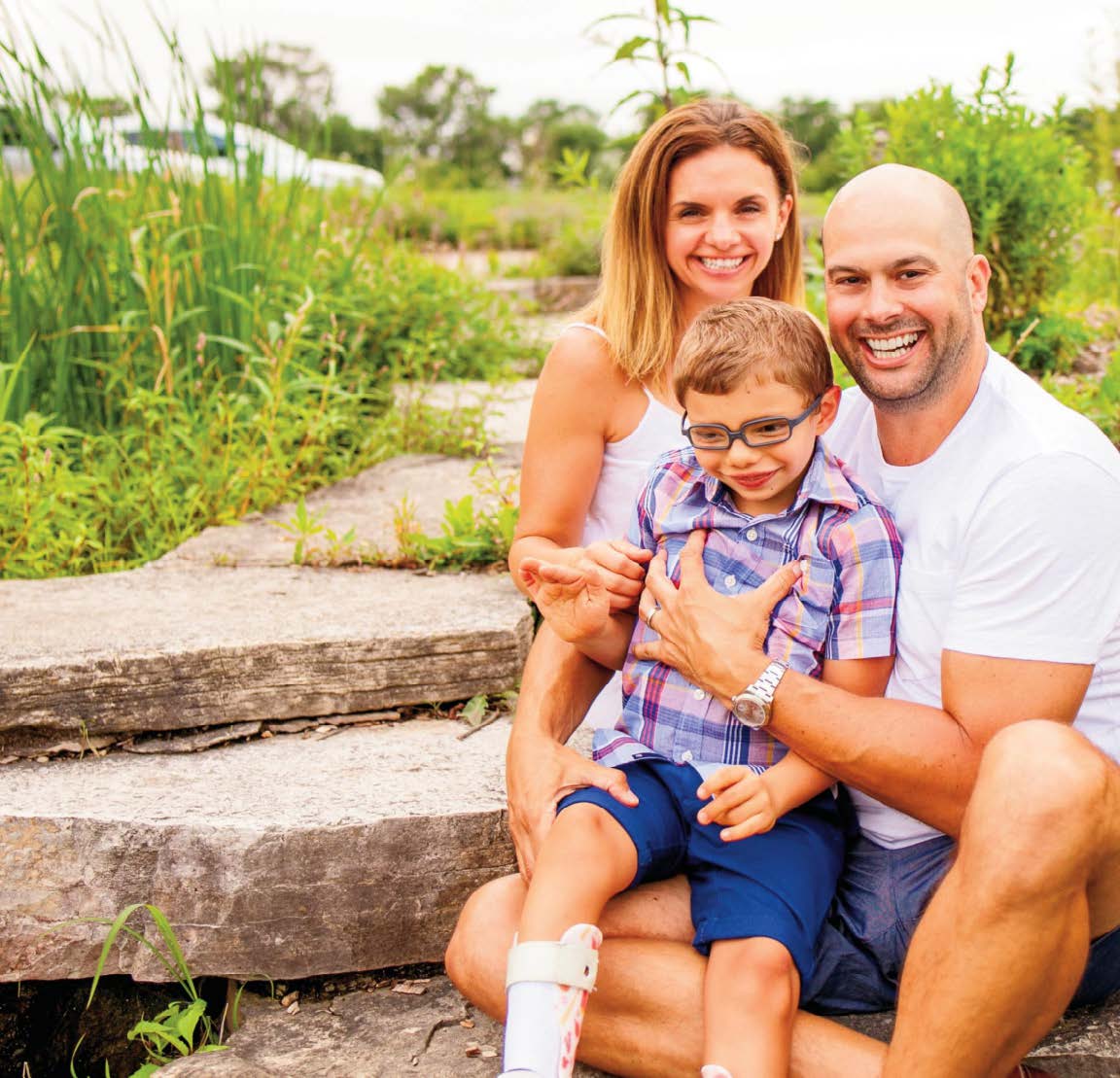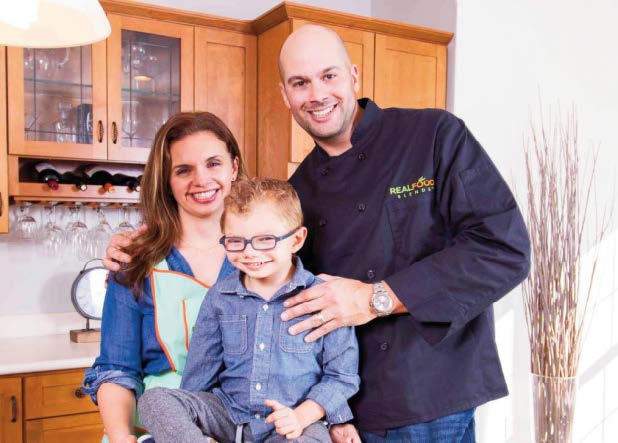COVER STORY
Mealtimes are about a lot more than just the food we are eating, and excluding a person from this socialization and bonding time just because they can't eat like the rest of the family can be hurtful and psychologically damaging to the entire family. Look for ways to bring back the joy of food and mealtime!

" IT TOOK US A LONG TIME TO GET HERE, BUT WE NOW SEE AJ'S FEEDING TUBE AS AN INTEGRAL TOOL IN KEEPING HIM AT HOME AND HEALTHY."

HEALTHY, HAPPY AND HOME: The Bombacinos (from left to right) Julie, AJ, Tony and Luca. "It took us years to come to terms with this and to finally look at AJ's tube as a huge blessing to our family – our son is here with us, relatively healthy and we can manage most illnesses at home."
Our son has, and gets all of his nutrition from, a feeding tube. Serving nutritious food that everyone will eat is hard enough for any family at mealtime, but caring for a child with a feeding tube presents a new set of challenges.
We were thrown into learning about feeding tubes very unexpectedly when our second child, AJ, had a 45-minute seizure when he was six months old. He had to have a feeding tube placed due to suspected aspiration after seizures. Interestingly, most feeding tubes are placed not because the digestive system doesn't work, but because the person can't safely get food into their stomach. Chewing and swallowing are complex neurological functions that can be compromised due to a number of conditions and factors.
Estimates put the number of people livHEALTHY, HAPPY AND HOME: The Bombacinos (from left to right) Julie, AJ, Tony and Luca. "It took us years to come to terms with this and to finally look at AJ's tube as a huge blessing to our family – our son is here with us, relatively healthy and we can manage most illnesses at home." ing at home with a feeding tube in the United States at 500,000 to one million. Chances are you know someone who has had a feeding tube for nutrition at some point in their lives. There's been a marked increase in the number of feeding tubes placed over the past 15 years, primarily due to medical advances keeping people alive longer than ever before. Think of NICU babies, those with ALS or certain oral cancers – the feeding tube extends the life of many with these conditions.
many with these conditions. Now, almost six-and-a-half years after AJ had his tube placed, the day-in-the-life picture of our family probably looks very similar to most, with the big exception that AJ cannot walk or eat with his mouth. These physical limitations, along with his inability to verbally communicate his needs, add a new level of complexity for dual-working parents with two school-aged children.
Feeding AJ through his tube has become the norm for us. Aside from the obvious health benefits of eating a diet of real, whole foods (no added sugars or preservatives in his diet, he NEVER complains about eating his veggies!) – we also have no problems giving his daily medications, no arguments about AJ not liking something, and complete control over what goes into his body. It took us a long time to get here, but we now see his feeding tube as an integral tool in keeping him at home and healthy.
There are challenges we still face, such as going out to dinner as he gets incredibly bored sitting around watching us eat. AJ can't self-feed so every morsel of food he gets is fed by one of us. We have to watch for physical clues when he's full or doesn't want to be fed, and the psychological implications of not being able to nourish our son the same way we do our daughter and the social aspects of sharing family meals still impact all of us, even after all these years. So what does a typical day look like for us? AJ's day begins between 5 and 6 a.m. For breakfast, we give him two seizure medications, eight ounces of water, 16 ounces of his blended food and then flush with a little more water. We syringe (bolus feed) AJ using two-ounce syringes so between the two medicine syringes, we are drawing up and pushing another 12 syringes within this hour. He can take his food faster, but we don't like to rush his breakfast too much. Then it's off to school before seven a.m. If he's home for the day, we repeat the same 12 syringes (eight ounces water and 16 ounces of food) for lunch.
Around four p.m., AJ gets half a dose of seizure meds and four ounces (two syringes) of water. Sometimes we'll add a snack of his blended food if we think he's hungry or if dinner may be later. At dinnertime, AJ gets two more medical syringes of his seizure medication, four more ounces of water and 16 ounces of blended food (which is eight more syringes).

It equates to five individual medical syringes being pushed per day, and 36 times we pull up individual two-ounce syringes of water and food per day. We find the syringe (bolus) method works best for AJ and our family. Some people prefer to use pumps or gravity bags, but AJ won't sit still long enough for that. We go with what works best for us and we urge others to find the method that works for them.
We then start the cleaning process of all these syringes! If you've ever bottle-fed a baby, you can relate to the amount of work that goes into hand-washing bottles and parts – it's a similar process for us. This is the bare minimum when he's well and does not need additional medications or more fluids during warm weather. For years, Julie was also prepping, cooking, chopping and blending his meals ahead of time as he was one of the many people with a feeding tube that cannot tolerate the commercial formulas that were on the market prior to us creating Real Food Blends. Now, AJ gets our ready-to-feed real food blends for most meals, although we occasionally blend fresh food for him.
The daily to-do list of keeping any child fed can be long and laborious, but the added step of having to tube-feed every meal is often exhausting. Whenever we get down about having to feed AJ, or see the stares we get when feeding him in public, we try to remember it's possible AJ wouldn't be here without his feeding tube. It took us years to come to terms with this and to finally look at his tube as a huge blessing to our family – our son is here with us, relatively healthy and we can manage most illnesses at home. Another positive is that AJ serves as the Chief Inspiration Officer of Real Food Blends, the company we created to provide actual 100% real food blended meals for people with feeding tubes.
ABOUT THE AUTHORS: Julie and Tony Bombacino are the co-founders of Real Food Blends, maker of 100% real food meals for people with feeding tubes. Prior to Real Food Blends, they both spent 15+ years in various marketing leadership roles helping companies like Road Runner Sports, United Airlines, Andersen, optionsXpress and Restaurant.com reach new levels of success. They both enjoy mentoring the next generation of marketers and entrepreneurs. They reside in Indiana with their two children, Luca and AJ.
FOOD FOR THOUGHT : FIVE FEEDING TUBE TIPS FROM THE BOMBACINOS
We've learned a lot over the years and from our son, aJ. our advice as veteran tube-feeding caregivers:
1. Try food. If the digestive system is still intact and working, it's very possible that a person with a feeding tube would still benefit from a wide variety of whole food. Feeding tubes do not have to mean relying only on commercially-prepared formulas. The health benefits of eating fruits and vegetables are obvious, and we think most will find there's a psychological boost too, since its not nearly as depressing to feed a meal like the rest of the family is having versus a can of white, processed, synthetic formula. Always consult your medical team before making any dietary changes.
It will get better. Those first few months with AJ were so incredibly difficult for our entire family. We were trying to figure this whole thing out. He was miserable with constipation and daily vomiting, and the stress level in our home was sky-high.
Seek support. Join tube-feeding groups to learn tips and tricks, but also to not feel so alone on this journey. We are a part of a wonderful Facebook community that relies on each other for support.
There are very common side effects that come along with a formulaonly diet, but this can be managed, sometimes by adding real food to the body and sometimes with additional medications. Either way, daily vomiting, constipation, diarrhea, nausea, severe reflux, extended feeding times, volume intolerance, etc. are all signs of formula intolerance and can typically be treated.
Lastly, maintain your family mealtimes. Have a chair at the table for your loved-one with a feeding tube so they can enjoy the conversation and feel included. Mealtimes are about a lot more than just the food we are eating, and excluding a person from this socialization and bonding time just because they can't eat like the rest of the family can be hurtful and psychologically damaging to the entire family. Look for ways to bring back the joy of food and mealtime!